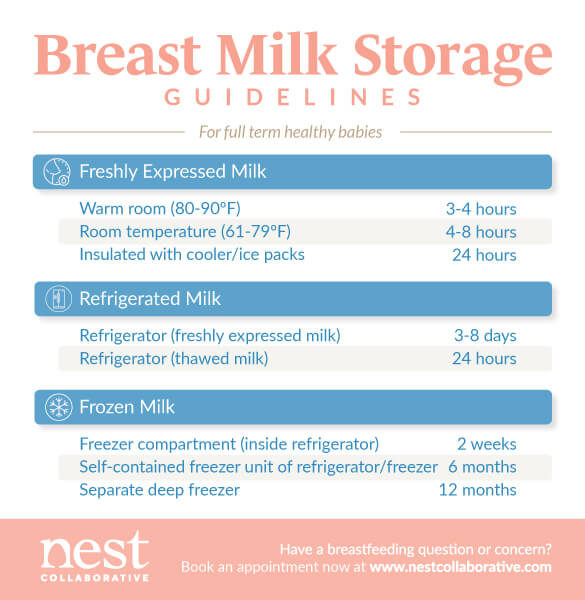
You’ve built up a breast milk stash, but what exactly do you do with it? From keeping your bottles clean to setting up your freezer, we’ve got the tips to staying organized.
After days or weeks of pumping, you’ve built up your breast milk stash. You should be proud of yourself. (We know we’re proud of you!) You’ve got a solid supply of liquid gold stored away for going back to work, early morning feeds, date night, or (let yourself dream!) a weekend away.
But that milk can’t just hang out in the fridge forever, and your freezer can only handle so much frozen breast milk.
You need a plan.
You need a system.
Look no further—we’ve got you covered.
Breast milk is powerful stuff. It’s full of critical nutrients and antibodies that are uniquely made for your baby.
But breast milk is also sensitive. It has to be handled carefully.
When you nurse, your milk goes directly from your breasts into your baby’s mouth. There’s not much opportunity for cross-contamination. For pumping parents, though, there are more significant risks, starting with HOW you’re pumping. To avoid hazards, follow these practices:
*Only use storage bags intended for milk storage.
When storing your breast milk in the fridge, keep it either in the bottle or bag you pumped in or transfer it to a clean, food-grade container made from glass or plastic. Make sure to choose a container with a tightly fitted lid — you don’t want to lose any of that milk! — but avoid anything with the recycle symbol 7, as they may contain potentially harmful BPAs.
Pro-tip: While bottles and food-grade containers are helpful for short-term storage in the fridge, they can be impractical for longer-term storage in the freezer — they are bulky, expensive, and less convenient for transporting. That’s why it’s best to transfer milk to milk bags for freezer storage.
Not all spots in your fridge are equal when it comes to storing breast milk, either. Your safest bet is at the back of the refrigerator, where the temperature will stay consistently cool even when you are mulling over what type of yogurt you want for a midnight snack. The least safe place? The door of the fridge — temperatures fluctuate there each time you open and close the door.
How long can I keep breast milk in the fridge?
You can store freshly pumped milk in your fridge for up to 4 days. For dethawed milk, you can keep it in the refrigerator for up to 1 day.
For parents who are regular pumpers, storing breast milk in the fridge may not be sufficient. After all, your baby can only go through so many bottles in a day. That’s why lots of parents turn to their freezer for help.
How to store?
If you’re storing milk in your freezer, the best practice is to cool it in the fridge before putting it into the freezer. Then, once you’re ready to transfer it to the freezer — remember, within 4 days! — transfer the milk to breast milk storage bags.
Leave an inch of space or more in the bag, though. Like any other liquid, breast milk expands when frozen. Therefore, it’s helpful to store milk in various quantities. Doing so gives you the option of topping off an extra hungry baby without warming up too much extra milk.
Here are a few other tips for managing your frozen breast milk stash:
According to the CDC, you can safely freeze breast milk for between 6-12 months at 0° Fahrenheit or lower, with 6 months being ideal and 12 months acceptable. Find a packet of breast milk beyond 12 months? Don’t throw it out — it can be used for home remedies, milk baths, lotions, soaps, and more.
If your freezer can’t handle all your breast milk — or your family wants more space in the fridge for ice cream and freezer pops! — a deep freezer can be a great solution. Storage practices are the same as for your regular refrigerator, but you can implement a few extra organizational steps to make your stash easier to manage. (After all, no parent wants to be buried under an avalanche of frozen breast milk at 5 am.)
Ready to feed your baby? Here’s what you need to know about thawing, warming, and serving your baby pumped breast milk.
When feeding your baby pumped milk that’s been chilling out in your fridge, there’s not too much you need to do. If it’s stored in bags, transfer it to a clean bottle or cup. You can warm the milk up if your baby prefers it warm, but it’s not necessary.
If you do warm your breast milk, run the bottle under warm water or use a bottle warmer. Specifically, one that’s made to warm human milk. Never heat breast milk in the microwave, boiling water, or standard bottle — these methods destroy critical nutrients. What’s more, they can create hot spots in the milk that may scald your baby’s mouth.
The final step before serving: Gently swirl your breast milk to incorporate those rich fats.
Breastfeeding myth: Have you been told to “Never shake your breast milk”? It’s a common tidbit shared with parents for years, but it’s not evidence-based advice. While there’s no need to give your breast milk a vigorous shake, it’s not going to hurt your breast milk either.
Defrost frozen breast milk either in your fridge or in cool water. Don’t let it thaw at room temperature. (And, as above, don’t thaw it in the microwave or boiling water!)
Once you’ve thawed the frozen milk, it’s safe to keep it in the fridge for up to 24 hours or at room temperature for up to 2 hours.
But remember: once milk is thawed, there’s no going back to the freezer!
When feeding your baby pumped milk, use paced bottle feeding with the bottle of his/her preference. How much your baby eats at any given feeding depends on his/her age, needs, preferred meal schedule, and more. That being said, most breastfed babies will take between 2-4 ounces each feeding.
Got leftover milk? You can keep it at room temperature for up to 2 hours after your baby finishes eating or pop it back in the fridge for the next feeding. (Even if it’s more than 2 hours away.)
Figuring out how to handle your breast milk stash can be overwhelming. That’s why we’re here. If you’ve got questions about best practices for storing and handling your breast milk, let’s talk. Our IBCLCs can help you evaluate your options and figure out how to meet your goals. Book a convenient online video appointment today.
